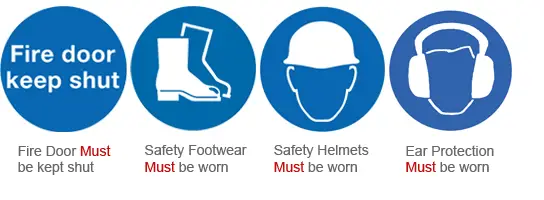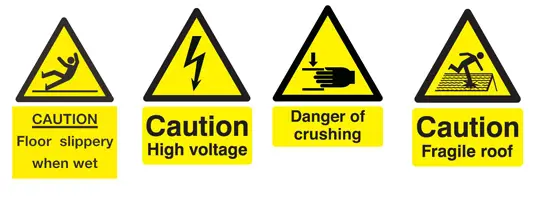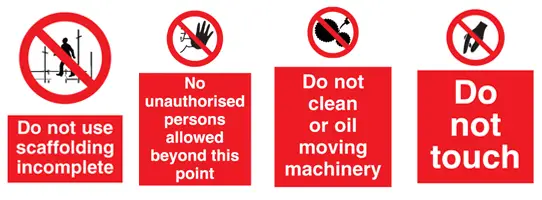Health and safety signs are used to provide visual aids in almost every working environment today, these safety signs come in all different shapes, colours and sizes and each one has a specific safety rule or procedure attached to it.
Understanding the different health and safety signs whether it be hazard signs or mandatory signs is absolutely critical towards promoting a safe working environment for both workers and visitors.
This is because quite a few of these safety signs do not carry a text-based rule or command they instead display a simple illustration.
It’s practically impossible to visit any public building without noticing their health and safety signs on display, these are put in direct view of visitors or customers so that in the event of an emergency, their instructions can be easily followed.
One of the most prominent safety signs you would find in most buildings would be the fire exit sign, this sign is used to point viewers to their nearest fire exit.
CSCS Health and Safety Signs and Meanings
Some of the most popular health and safety signs can be placed into these categories. Prohibition signs, mandatory signs, hazard signs, warning signs, floor signs and exit signs. Here are a few of the most common health and safety signs you’re likely to come across on a daily basis.
Mandatory Signs
Mandatory signs are used to imply that an action must be done, these include fire doors must be kept shut, safety footwear must be worn, safety helmets must be worn, ear protection must be worn etc.
These types of health and safety signs are normally circular and blue and white in colour like the examples below.

Hazard Signs
Hazard signs are used to warn employees or visitors that a potential hazard is present, this includes anything that can cause physical harm to a person.
These types of health and safety signs are triangular in shape and normally yellow and black like the examples below.

Prohibition Signs
As the name implies, these health and safety signs are used to prohibit a person from carrying out a certain action for example the no admittance safety sign is used to tell employees or visitors that they should not go beyond a certain point. These signs are usually red and white like the examples below.

Safe Condition Signs
Safe condition signs are green and white signs which indicate an area or place of safety. These can be fire exit signs, first aid signs, emergency eye wash station signs etc.

Tips for remembering health and safety signs
The quickest and easiest way to remember the types of health and safety signs is to use the traffic light method.
- Red – Stop, do not proceed
- Yellow – Be prepared for hazard
- Blue – This would be like police lights, you must do what they say
- Green – Safe to proceed
The importance of Health and Safety Signs
With so many potential hazards in the workplace, it is essential to ensure that health and safety signs are clearly visible. Properly implemented health and safety signage can prevent accidents, protect employees against hazardous chemicals and materials, and keep people safe around dangerous machinery.
Health and safety signs aren’t just used to alert workers of potential dangers; they also serve as a reminder of safe practices while working. Signs are a great way to communicate helpful information such as the location of emergency exits or fire extinguishers, evacuation protocol, protective gear requirements, etc. This helps ensure that employees have the most up-to-date instructions for avoiding danger in their specific workspace.
Another key benefit of having health and safety signs on-site is that they’re often required by law. Depending on your company size, industry and location there may be specific regulations governing the installation of appropriate signage. It’s important for your employer to consult with local authorities and experienced safety professionals to determine exactly which signs apply to your workplace.
Health and safety signage should be placed in strategic locations throughout the workplace where they will be easily visible. Each sign should include a clear message as well as any instructional steps needed to safely follow procedures in that area.
Additionally, all signage must be frequently inspected to ensure they’re still legible and not damaged or faded from use over time. Taking these simple steps can go a long way towards keeping your workplace safe and secure!
I hope this brief introduction to the different types of safety signs has made you more aware of how safety signs work and why it’s so important to be able to identify the different types of health and safety signs.
Test your knowledge with our CSCS health and safety signs test.
